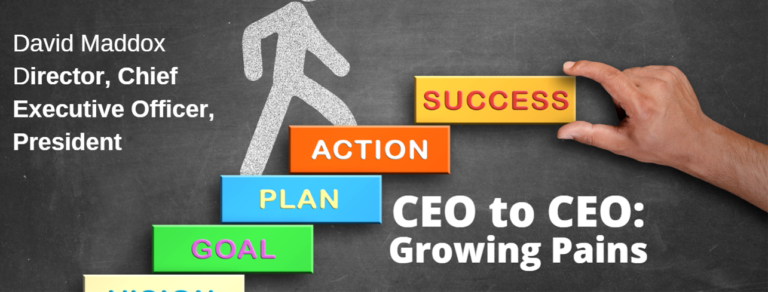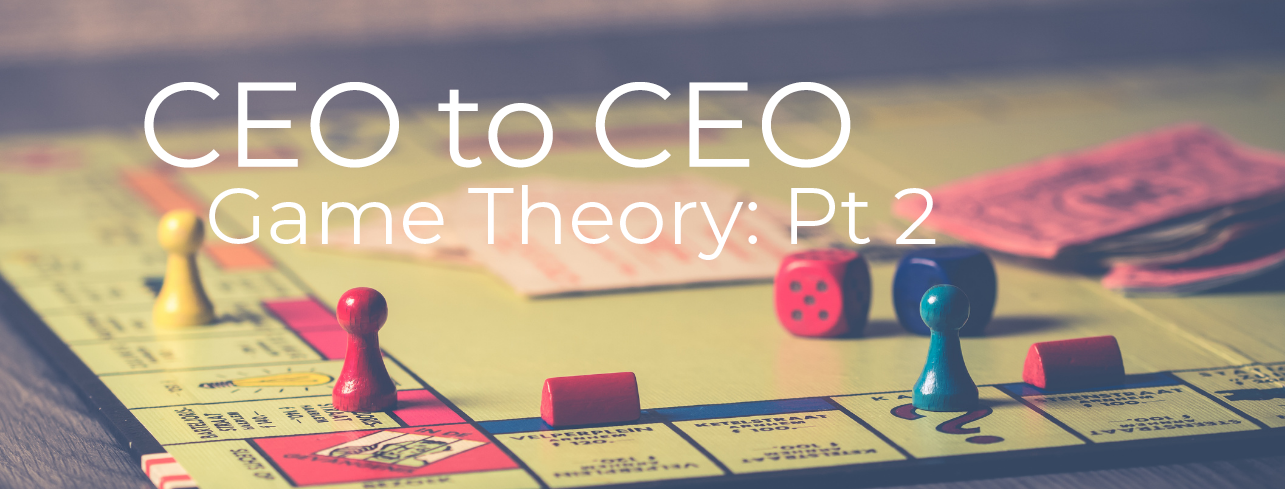CEO to CEO – GROWING PAINS

Every entrepreneur wants to grow. Growth is the natural order of things. As the saying goes—“if we aren’t growing, we’re dying.”
But growth involves suffering today for a payoff tomorrow. “Growing pains” aren’t reserved for awkward teenagers who suddenly gain six inches in six months. Every person, project, family and organization suffers discomfort, dislocation, angst, and all the emotional stress which attends growth.
And the pain is NOT evenly distributed. The mouth can enjoy the whole cherry pie, and a half gallon of ice cream on top. The stomach has another experience. The heart, liver, pancreas, and arteries do too. I can bring in $20 million in new business tomorrow—delicious to me, but my team then has to absorb and digest all that fresh catch.
A fishing boat captain is responsible for the safety of his crew and guests. He knows the basic protocols—proper equipment, communication of key rules, attention to the time and weather, etc. From there, he’s about finding the fish. Most of his work steering the ship is oriented toward maximizing the potential haul.
As a CEO who wants to grow, I am like the fishing boat captain. I am forever maneuvering toward how we might best employ the day at sea—determining what varieties of fish are in season, where we are likely to find them, the aptitudes of my guests and crew, the potential of our bait and equipment, and how I must adjust course based upon what is working/not working against the backdrop of how many hours of sunlight remain.
Over time, as I learn to optimize my boat and crew within my chosen locale, I get a good sense of what an average catch looks like—adjusting for season and weather. From there, growth means new capital investment—whether for upgraded equipment, more personnel, and/or better boat(s).
Growth always depends upon investment, though the likely return on any given investment varies. Some investment decisions require broad reconsideration of opportunities abandoned in favor of a single big one. Others are “no-brainers.” In fact, one major decision typically dictates a string of consequent decisions which must take place almost automatically—without thought, question, or (God forbid) second-guessing.
For example, when parents have a child, that decision sets forth a series of consequent decisions which last a lifetime. You cannot “send the child back.” He requires feeding, diapering, potty-training, nurture and admonishment, love, and guidance for years and years.
Starting a business is similar. Like a baby, it cannot do anything for itself in the beginning. Growth is slow and painful. The joy and glory in the process can certainly make it all worthwhile; but the crying, the smells, and the sleepless nights require automatic assent and attention.
Second-guessing while raising a child or building a business is deadly. The major decision has already occurred. Now the attention which first went into decision-making must get consistently directed and applied toward execution. Any distraction disrupts progress and invites disaster.
Isn’t there a place for reappraisal? For modifying the plan? Yes. Absolutely. Planning involves review, adjustment, redesign. But only within the appropriate time frame. Big decisions which span long timeframes fence in the arenas for all of their subsequent consequent decisions.
To maintain and achieve long-term goals, they must govern the scope of all the shorter-term goals nested within the longer timeframe. Making sure that happens requires ongoing attention. Having a team collaborating toward common goals requires time together as a team reviewing, affirming, and orienting their plans to align with the long-term goals.
Planning operates within parameters defined by specified goals and time. The planning function determines goals measured by timeframes, and action-items for execution within those timeframes. A ten-minute plan is very different than a plan for my day. The plan for my day is very different than a plan for my year, though they should be correlated and mutually consistent.
The usefulness of any plan depends upon accepting a distinction between the planning function and its execution. An architect designs a building plan; a general contractor executes it. Neither can properly perform the other’s role.
As CEOs, or human beings for that matter, we wear both hats. We are architects when we plan our work; we are contractors when we execute our plan. The functions are distinct and require greater and greater separate and distinct attention and devotion the more complex the plan/timeframe.
We first plan our work; we then work our plan. We do not freak out during execution phase and change the plan midstream. We do not “plan on the fly”—changing the plan because we are panicking or feel like the execution is failing. Such temptations are many.
Planning and execution are such different functions that the human brain cannot accomplish them simultaneously. If we could, then planning would have no value. It would become obsolete. But people are so tempted to try and mix planning and execution together.
The result, as most every book on building a business warns—identifying the failure-to-plan as a primary obstacle to success—is chaos. The novice thinks he can do both at once; the wise CEO understands the necessity of cool-headed, impartial planning which can prevail over, govern, and survive all the horrors which occur on the building site between breaking ground and finished project.
The difference between planning and execution is an issue of timeframe. When I plan my day, I consider the big picture of resources and opportunities. What are my biggest opportunities/responsibilities? What do they require of me? If my resources (time, money, relationships) are insufficient, how should I best mitigate potential loss or adjust my goals and expectations? Reconciling these issues, I confirm my schedule and resolve my priorities.
Once my planning is complete (my schedule and priorities are outlined and determined), I can concentrate upon executing my day without the distraction of perpetually reconsidering all the pros and cons which I already sifted through during the planning stage.
A decent plan, which ideally allows plenty of margin to accommodate surprise developments, allows me to apply my attention 100% in-the-moment as I conduct my day. I’m present, not distracted, confident and free to attend to the item in front of me, knowing that all my other concerns are already accounted for.
Can an emergency disrupt my plan? Yes, but that won’t happen often if my plans are reasonable and sufficiently flexible to accommodate a variety of potential developments. If items keep “spilling off my plate,” then I know I’ve been piling it too high—putting too much on my calendar. My experience informs my planning function and I then moderate how I plan tomorrow, gradually learning to consistently calibrate my daily plans so that I optimize opportunities with minimal over-stress.
Just as I plan my day and then execute my day, the same goes for my week, my month, my year, my career. If I attend the same exercise weekly, considering my opportunities, resources, priorities, and conclude with decisions about my week, I am then free to execute my weekly plan without the distraction of constant re-evaluation. Within the scope of my weekly plan I devise daily plans, just as within the scope of my daily plans I devise plans of shorter duration to achieve the goals defined by my daily plan.
Self-discipline contributes as follows: during execution I do NOT attempt to replan. I “obey” the plan already in place. The contractor respects the architect’s authority. He knows the plan will fail without a governing blueprint.
IF a situation arises which is so dire as to require a fundamental revision of the operating plan, then I must switch modes. I must stop and take the time necessary to review the plan, thoughtfully recall its original logic and reasoning, evaluate whether new conditions genuinely require a revision, and then make any necessary revision as MINIMALLY as possible.
But when I do that, I am “going back to the drawing board.” I am removing my contractor’s hat and fully readopting the role, perspective, concerns and priorities of the architect.
The contractor wants to execute, to get the job done. But the architect’s focus is different. The architect wants to get the plan right. The architect is looking down the road, taking the entire project into consideration, reviewing costs and benefits, chasing down multiple rabbit trails of potential ramifications to every change in the plans.
Plan changes mid-course are occasionally necessary, but very expensive. To change the blueprints, the contractor must retail his team, or put them on hold while he goes back to the architect. His sense of urgency is palpable.
Anything beyond the most minimal effective revision will undermine and confuse the planning/execution function. And so we learn to resist the temptation as contractors to attempt architectural design changes on-the-fly. There will be time tomorrow to devise a new daily plan. There will be time this weekend to devise a new weekly plan. There will be a weekend set aside next month which is already devoted toward our annual plan.
Why is this article which supposedly addresses growth so focused upon planning? Because successful growth is essentially a function of good planning. Good planning will engender growth; the absence of good plan will torpedo growth.
When we methodically plan and execute, plan and execute, we fend off the chaos which arises from panic or other emotional responses to the myriad surprises and disappointments which invariably accompany the execution phase. The better we get at planning, and trusting our plans as we execute them, the more efficiently we achieve our goals. Better than that, the more we avoid allowing small problems to unnecessarily mushroom into big ones.
Growth is achieved via good planning. Harmony and cohesion of team performance is achieved via good planning TOGETHER WITH THE TEAM and ongoing communication.
But execution isn’t just blind obedience to the plan. Thought is required. Issues arise. Planning operates at the micro-level as well as at the macro-level. The trick is maintaining perspective, a sense of proportion, and cultivating cohesion between the larger scope and the smaller scope.
Every issue arising in the execution phase signals the need to step back and at least micro-plan. Perhaps a ten-second plan solves the issue. Great. That happens. Perhaps it takes a minute. That happens too. Sometimes we need ten minutes—to pray, reflect, calm down, rest.
Sometimes the problem demands an extended pause. Not every solution is spelled out in the blueprint. Shelving an issue until tomorrow when no reasonable solution presents itself is often better than plowing ahead without sufficient confidence. When the car makes loud noises I don’t understand, I want to stop driving and get some expert advice.
The more versatile every team member becomes in managing their own planning/execution sequences, and also in doing so in conjunction with others on their team, the more effective they become. And growth, ultimately, is a function of our effectiveness—as individuals and as groups.
Growth also requires well-defined goals. Goals and metrics are essential to growth and are the substance of good planning. This piece does not address the mechanics of planning—the evaluation of opportunities, costs, choices, etc. How to plan is another grand subject. But we begin the creation of growth by “separating the land from the sea.”
“Planning and execution” are the “land and the sea.” They comprise the world of growth creation. Master planning and execution, and growth will happen. The better we plan, the more accurate our predictions and the more likely we will achieve our metrics and hit our goals. The better the blueprint, the easier it will go for everyone on the construction site.








